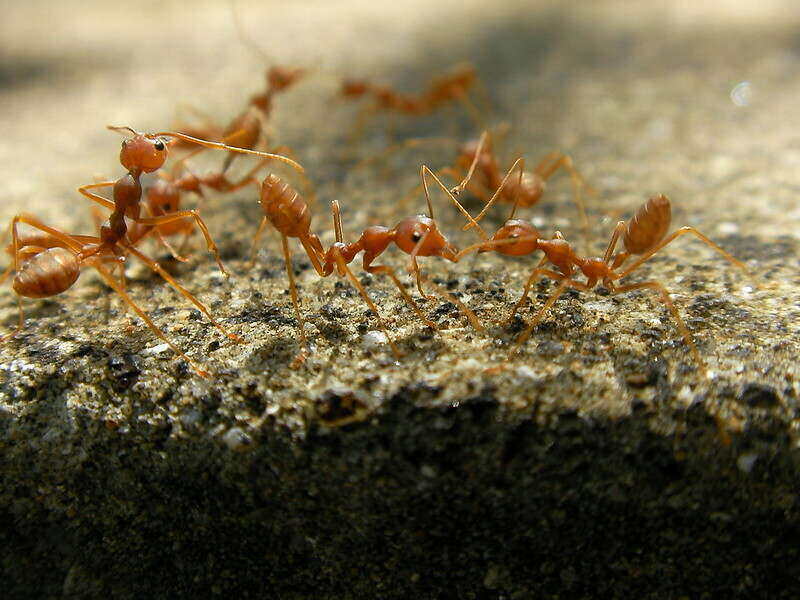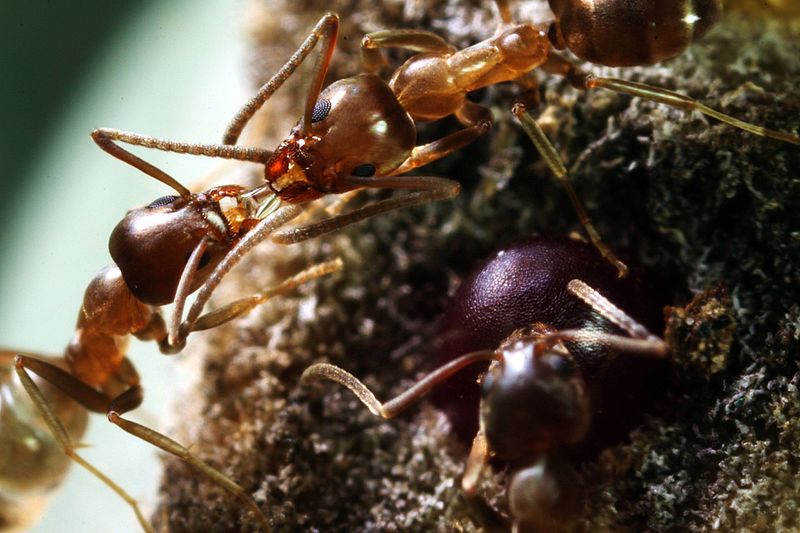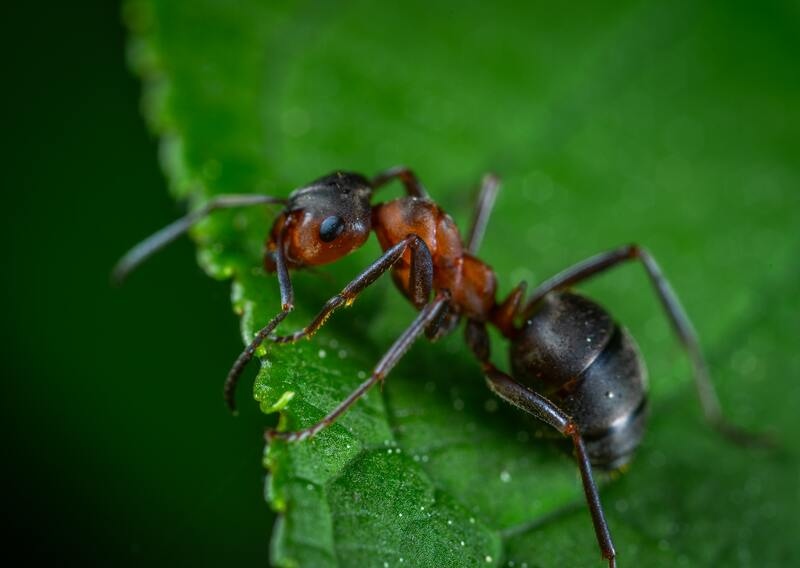
Ants may be small, but they can do big damage if you let them. We’ll show you 8 types of ants that can damage your yard and how to identify them.
Proper ant identification will help you spot the type of damage they do, locate where they’re nesting, and perform the best treatment.
1. Fire Ants

Fire ants are an annoying pest that not only bite, but also damage your lawn. These ants carry a painful sting that can cause allergic reactions in people who have ant allergies. The ants themselves are small and red, with a black abdomen that ends in a stinger.
Damage to the Lawn: Fire ants damage lawns by killing the grass’ root systems, making them a major threat. Their nests also displace grass and can kill the area of the lawn they’re in.
Nests: Fire ant nests can either look like dome-shaped mounds or just patches of disturbed earth. You can tell a nest apart because, unlike other ant mounds, it won’t have an opening in the center. They typically pop up after rainfall or watering.
For information on fire ant control, read here: How to Get Rid of Fire Ants
2. Argentine Ants

Argentine ants are another species that can do major damage to your grass. They look rather similar to many other ant species, but are smaller than average. They’re also dark brown and hairless.
Damage to the Lawn: Argentine ants harm lawns by farming mealybugs, another pest that creates a substance called honeydew. This honeydew is what the ants eat, rather than the mealybugs themselves. Since the mealybugs feast on plants like your flowers or grass, they’re a major problem. If you have argentine ants, mealybugs aren’t far behind. Then you’ll have to get rid of the mealybugs and the ants.
Nests: Argentine ant nests are shallow. You can typically find them in out-of-the-way spots like the sides of buildings, under logs, or underneath plants.
Read here for info on controlling Argentine ants: How to Get Rid of Argentine Ants
3. Army Ants

Army ants are a species that are more common in other countries, but if you live in the United States, they’re mostly found in the South. They’re perhaps the most devastating species of ant to have for one simple reason: they eat everything. They’ve even been known to swarm and kill small animals.
The typical army ant is red in color with a spindly body and black eyes. You can identify them by their larger-than-average heads and prominent mandibles.
Damage to the Lawn: Army ants are voracious and will devour anything they can, including your lawn. Both the grass itself and any plants in your garden are at risk when these ants show up.
Nests: Unlike most other ants, army ants don’t make permanent nests. They’re nomads on a never-ending quest for more food.
4. Carpenter Ants

The words ‘carpenter ant’ refer to a few different ant species, all of which are harmful to lawns and much more. These ants can do devastating damage to your home if they get in.
Carpenter ants have two sets of wings, with the front wings longer than the hind ones. They can be distinguished from termites by their jointed antennae, darker colors, and narrow waist. You can tell them apart from other ants by their larger size, as well as their heart-shaped head. Carpenter ants can be black, brown, red, or a combination of the three.
Damage to the Lawn: Carpenter ants damage lawns by farming aphids and mealybugs for the honeydew they produce. They don’t nest in soil, so they won’t harm the lawn directly, but that doesn’t mean they’re any less of a threat. Those aphids and mealybugs will eat any greens they can, namely your lawn and garden plants.
Nests: Carpenter ants make their nests in wood instead of soil, so while you might not have to worry about them making mounds on your lawn, you should greatly worry about them boring into your home. Carpenter ants will hollow out wooden structures in your home to make their nests, which compromises their structural integrity just like termites.
Try tapping wood around where you’ve seen the ants. If they’ve made a nest inside, it should sound hollow, especially compared to intact wood. The ants may also get spooked and come out, which will be a definitive sign.
For information on carpenter ant control, read here: How to Get Rid of Carpenter Ants
5. Field Ants

Field ants are another ant species that have a painful bite, just like fire ants. Unlike fire ants, field ants do not sting, and while their bites are typically painful, they’re ultimately harmless.
These ants can be red, black, or even pale yellow. They’re larger than average and are often mistaken for carpenter ants. To distinguish field ants, look to their bumpy thorax and the three small white dots on their heads. These dots are known as ocelli.
Damage to the Lawn: Field ants can damage your lawn by destroying the root structure, just like fire ants. Field ants will also make unsightly mounds that can smother grass or even damage your mower blades.
Nests: Field ant nests look like the typical ant nest and can grow to extreme size. They can be up to 4 feet wide and up to 2 feet tall. Field ants may also nest in rotting logs.
6. Funnel Ants

Funnel ants are a species that, like fire ants, both threaten lawns and have a painful sting. The ants themselves are light brown or tan in color. There aren’t many ways to distinguish this ant from other species, but thankfully funnel ants’ nests are hard to miss.
Damage to the Lawn: Funnel ants damage lawns by excavating soil from around the roots, which deprives the grass of vital nutrients and compromises the structure of the entire lawn. They also do damage with their nests, which smother small areas of the grass, and by farming mealybugs. These bugs are a triple threat, so it’s especially important to remove them ASAP.
Nests: Funnel ant nests are hard to miss. They’re where the ants get their name, after all. The nests look like funnels with wide entrances.
7. Leafcutter Ants

Leafcutter ants, like their name suggests, are a species that harvests leaves from plants. However, these ants do not eat the leaves themselves. Instead, they use the leaves to feed a fungus called Lepiotaceae, which is their only food source.
The ants themselves can be identified by their long legs and hairy, reddish-brown bodies. They form long lines as they carry leaves, which should be an obvious indicator.
Damage to the Lawn: Leafcutter ants damage lawns both by harvesting grass to feed to the fungus and with their nests, which smother grass and create sunken areas in the lawn.
Nests: Leafcutter ant nests look like large mounds of dirt, possibly with multiple openings. These ants prefer dry, well-drained soil to make their homes in.
8. Harvester Ants

Finally, we have harvester ants. This is another group of ant species with a painful sting, even more so than fire ants. In particular, the Maricopa harvester is believed to have the most toxic insect venom on the planet. Another notable harvester is the Florida harvester ant, which is common in Florida and North Carolina.
While physical descriptions vary among different species, most harvester ants are red, brown, or black, and have large, broad heads.
Damage to the Lawn: Aside from being a general menace, harvester ants damage lawns not only by making nests, but also by clearing all the vegetation around them. This results in big bare patches on lawns, which is obviously both unsightly and bad for the grass.
Nests: You can identify a harvester ant nest by the lack of vegetation surrounding it. The nest itself looks like a typical ant nest, but the lawn around it will be completely bare in a large circle.
FAQ About Ants
Are there any ants that help lawns?
There are, indeed. Many species of ants can help your lawn by killing other bugs, ones that would eat your plants. They also aerate your soil for you and provide free fertilizer. As a matter of fact, beneficial ants are the majority.
For example, black garden ants help pollinate flowers in your garden. Flying ants can control aphids and mealybugs, in addition to aerating soil and recycling nutrients.
Will ants outside my house make nests inside?
If you have ants in your yard, it’s entirely possible for them to come inside. However, they won’t set up shop indoors. Ants will live outside but come into your home in search of food.
How long do ants live?
It depends. There are thousands of different ant species, each with their own average lifespan. Even among the same species, their longevity can vary depending on their sex.
Male ants typically only live long enough to mate with the queen, which may only be a few weeks. Female ants, on the other hand, can live for much longer, from a few months to a year. The queens are the longest-lived of them all. The average lifespan of a queen ant is five years, and some have been known to last for decades.
Find Your Lawn Pro
While some ants can be beneficial for your lawn, others can do a lot of damage. If your lawn is overwhelmed by ants or other lawn pests, LawnStarter can connect you to a local professional. An expert can efficiently get rid of ants and prevent future invasions.
Main Photo Credit: surasak / Adobe Stock Free / License